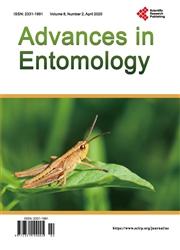Evaluation of Dryland Wheat Cultivars on the Market in South Africa for Resistance against Four Known Russian Wheat Aphid, Diuraphis noxia, Biotypes in South Africa
引用次数: 0
Abstract
An increased wheat yield potential under changing environmental conditions is a challenge in agriculture. Resistant wheat lines can yield more than susceptible wheat lines in the presence of Russian wheat aphid infestation. There are currently four Russian wheat aphid (RWA) biotypes known in South Africa with different virulence against different wheat cultivars. To keep up with the ever-changing patterns it is necessary to screen the cultivars for resistance against these Russian wheat aphid (RWA) biotypes. All the dryland wheat cultivars on the market were evaluated for resistance against the four known Russian wheat aphid (RWA) biotypes in South Africa. Through this evaluation, the status of Russian wheat aphid (RWA) resistance in South African dryland wheat cultivars can be updated to adapt to environmental changes and the wheat industry can adapt to changes in virulence of Russian wheat aphid (RWA) biotypes that may cause damage to Russian wheat aphid (RWA) resistant cultivars, subsequently affecting yield. Evaluations were done in the glasshouse by screening wheat cultivars against four different South African Russian wheat aphid (RWA) biotypes, RWASA1-RWASA4, under controlled conditions. The glasshouse evaluations showed that out of the 19 dryland wheat cultivars currently on the market in South Africa 16 are resistant against RWASA1, 7 are resistant against RWASA2, 7 are resistant against RWASA3 and 5 are resistant against RWASA4. Dryland wheat cultivars were also evaluated under field conditions at four different field localities. In the field, 5 cultivars were resistant to RWASA3 at two localities, respectively, and 3 and 5 cultivars were resistant to RWASA4 at two localities, respectively. Since Russian wheat aphid (RWA) damage can influence the final yield of a wheat cultivar significantly, changing conditions can influence both resistant cultivars, and the virulence of Russian wheat aphid (RWA). It is advisable to evaluate wheat cultivars on the market under different conditions and with all known Russian wheat aphid (RWA) biotypes in an area.南非市场旱地小麦品种对四种已知俄罗斯小麦蚜虫的抗性评价
在不断变化的环境条件下提高小麦产量潜力是农业面临的挑战。在俄罗斯小麦蚜虫侵害的情况下,抗性小麦品系比易感小麦品系产量更高。目前南非已知四种俄罗斯小麦蚜虫(RWA)生物型,它们对不同的小麦品种具有不同的毒力。为了跟上不断变化的模式,有必要筛选对这些俄罗斯小麦蚜虫(RWA)生物型的抗性品种。在南非对市场上所有旱地小麦品种对四种已知的俄罗斯小麦蚜虫(RWA)生物型的抗性进行了评价。通过该评价,可以更新南非旱地小麦品种对俄罗斯小麦蚜虫(RWA)的抗性状况,以适应环境变化,并使小麦产业能够适应可能对俄罗斯小麦蚜虫(RWA)抗性品种造成损害,进而影响产量的俄罗斯小麦蚜虫生物型毒力变化。在控制条件下,通过筛选小麦品种对4种不同南非俄罗斯小麦蚜虫(RWASA1-RWASA4)生物型的抗性,在温室中进行了评价。温室评价结果表明,目前南非市场上的19个旱地小麦品种中,16个品种对RWASA1具有抗性,7个品种对RWASA2具有抗性,7个品种对RWASA3具有抗性,5个品种对RWASA4具有抗性。旱地小麦品种也在4个不同地区的田间条件下进行了评价。田间分别有5个品种在2个位点对RWASA3产生抗性,3个和5个品种在2个位点对RWASA4产生抗性。由于俄罗斯小麦蚜虫(RWA)危害可以显著影响小麦品种的最终产量,因此改变条件可以影响抗性品种和俄罗斯小麦蚜虫(RWA)的毒力。最好在不同条件下对市场上的小麦品种进行评估,并在一个地区使用所有已知的俄罗斯小麦蚜虫(RWA)生物型。
本文章由计算机程序翻译,如有差异,请以英文原文为准。
求助全文
约1分钟内获得全文
求助全文

 求助内容:
求助内容: 应助结果提醒方式:
应助结果提醒方式:


